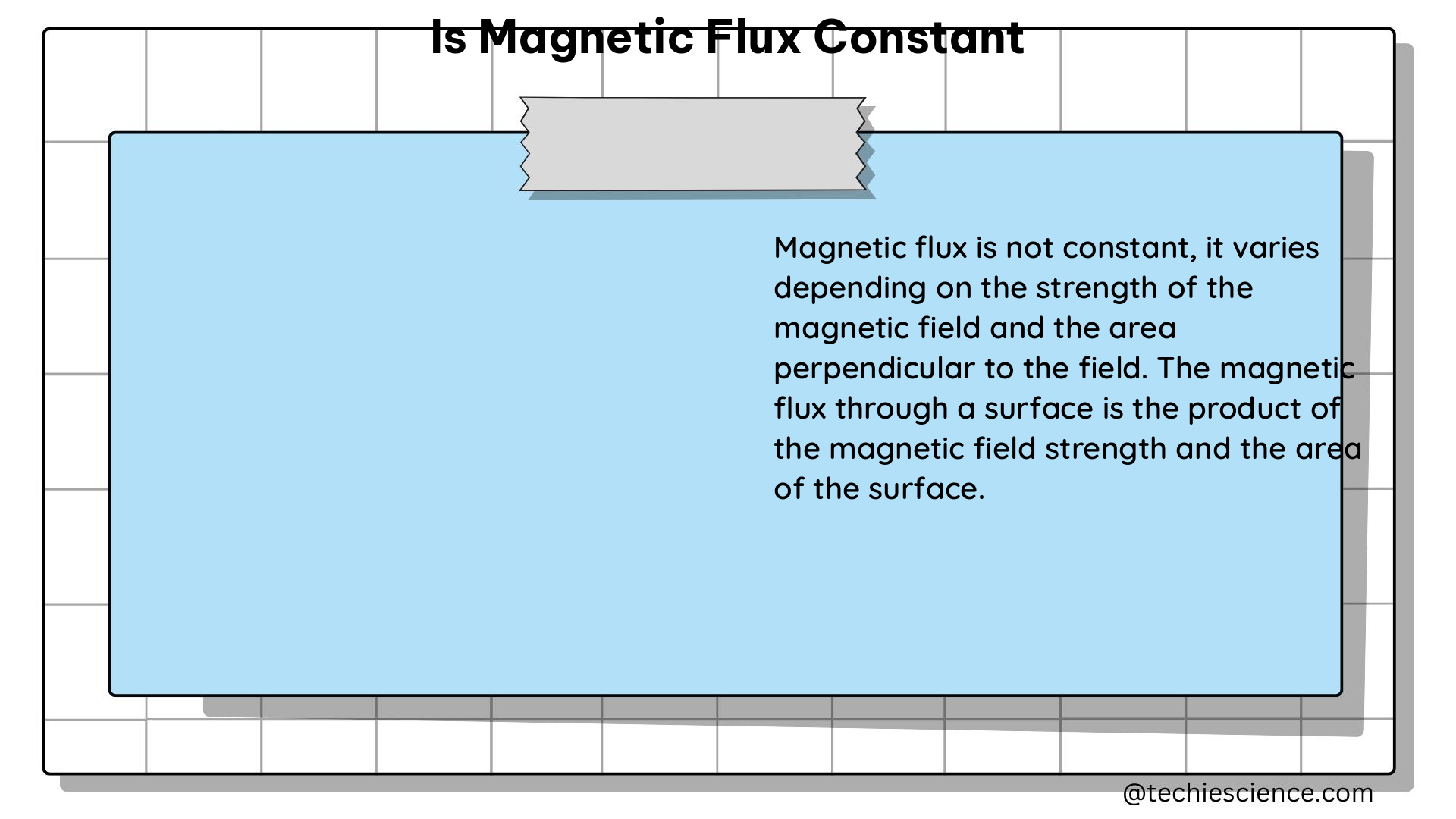Magnetic flux, represented by the symbol Φ, is a fundamental physical quantity that describes the amount of magnetic field passing through a given surface. The magnetic flux quantum, Φ₀, is a constant that represents the smallest possible change in magnetic flux, and it plays a crucial role in the understanding of superconductivity and the definition of electrical units in the International System of Units (SI).
Understanding Magnetic Flux
Magnetic flux is defined as the product of the magnetic field strength (B) and the area (A) over which the field is measured, as shown in the following equation:
Φ = B × A
The unit of magnetic flux is the weber (Wb), which is equivalent to tesla-square meter (T·m²).
Magnetic flux can be constant or variable, depending on the specific situation. For example, in a uniform magnetic field, the magnetic flux through a fixed area will remain constant. However, if the magnetic field or the area changes, the magnetic flux will also change accordingly.
The Magnetic Flux Quantum

The magnetic flux quantum, Φ₀, is a fundamental physical constant that represents the smallest possible change in magnetic flux. It is a crucial concept in the field of superconductivity and is defined as:
Φ₀ = h / (2e)
Where:
– h is the Planck constant (6.62607015 × 10⁻³⁴ J·s)
– e is the elementary charge (1.602176634 × 10⁻¹⁹ C)
The value of the magnetic flux quantum is approximately 2.067833848 × 10⁻¹⁵ Wb, or 2.067833848 × 10⁻⁷ Mx (where Mx is the unit of magnetic flux, the maxwell).
Importance of the Magnetic Flux Quantum
The magnetic flux quantum is a fundamental constant in the study of superconductivity and has several important applications:
-
Superconducting Quantum Interference Devices (SQUIDs): SQUIDs are highly sensitive magnetometers that can detect extremely small changes in magnetic flux, down to the level of the magnetic flux quantum. They are used in various applications, such as medical imaging, geophysical exploration, and fundamental physics research.
-
Quantum Hall Effect: The quantum Hall effect is a phenomenon observed in two-dimensional electron systems, where the Hall resistance takes on quantized values that are integer multiples of the ratio h/e², which is related to the magnetic flux quantum.
-
Josephson Effect: The Josephson effect describes the flow of current across a thin insulating barrier between two superconductors, and it is directly related to the magnetic flux quantum. This effect is used in the definition of the volt and the ampere in the SI system.
-
Fundamental Constants Measurement: Before the 2019 redefinition of the SI base units, the magnetic flux quantum was used to measure the Planck constant with high precision, which was then used to define the ampere and other electrical units.
Practical Applications and Numerical Examples
- SQUID Magnetometers: SQUIDs can detect magnetic fields as small as 10⁻¹⁴ T, which corresponds to a change in magnetic flux of approximately 10⁻⁵ Φ₀. This sensitivity allows SQUIDs to be used in various applications, such as:
- Measuring the magnetic fields of the human brain (magnetoencephalography)
- Detecting the magnetic fields of the Earth’s crust (geophysical exploration)
-
Searching for dark matter (fundamental physics research)
-
Quantum Hall Effect: In the quantum Hall effect, the Hall resistance takes on quantized values given by the formula:
R_H = h / (n·e²)
Where:
– R_H is the Hall resistance
– h is the Planck constant
– e is the elementary charge
– n is an integer
For example, if n = 1, the Hall resistance would be approximately 25,812.807 Ω, which is a fundamental constant known as the von Klitzing constant.
- Josephson Effect: The Josephson effect describes the flow of current across a thin insulating barrier between two superconductors. The voltage across the junction is related to the rate of change of the magnetic flux through the junction by the formula:
V = (Φ₀ / 2π) × (dΦ/dt)
Where:
– V is the voltage across the junction
– Φ₀ is the magnetic flux quantum
– dΦ/dt is the rate of change of the magnetic flux through the junction
This effect is used in the definition of the volt and the ampere in the SI system.
Conclusion
In summary, magnetic flux is a fundamental physical quantity that describes the amount of magnetic field passing through a given surface. The magnetic flux quantum, Φ₀, is a constant that represents the smallest possible change in magnetic flux and plays a crucial role in the understanding of superconductivity and the definition of electrical units in the SI system. The magnetic flux quantum has numerous practical applications, including in the development of highly sensitive magnetometers, the study of the quantum Hall effect, and the definition of electrical units.
References:
- Magnetic Flux: Definition, Equation & Change | StudySmarter
- Magnetic Induction (B) and Flux (F). Faraday’s Law explanation
- Magnetic flux quantum – Wikipedia
- Josephson effect – Wikipedia
- Quantum Hall effect – Wikipedia
- SQUID – Wikipedia
Hi, I’m Akshita Mapari. I have done M.Sc. in Physics. I have worked on projects like Numerical modeling of winds and waves during cyclone, Physics of toys and mechanized thrill machines in amusement park based on Classical Mechanics. I have pursued a course on Arduino and have accomplished some mini projects on Arduino UNO. I always like to explore new zones in the field of science. I personally believe that learning is more enthusiastic when learnt with creativity. Apart from this, I like to read, travel, strumming on guitar, identifying rocks and strata, photography and playing chess.